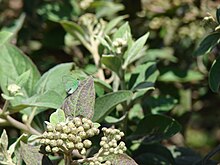
The Hawaiian crow or ʻalalā is a species of bird in the crow family, Corvidae, that is currently extinct in the wild, though reintroduction programs are underway. It is about the size of the carrion crow at 48–50 cm (19–20 in) in length, but with more rounded wings and a much thicker bill. It has soft, brownish-black plumage and long, bristly throat feathers; the feet, legs and bill are black. Today, the Hawaiian crow is considered the most endangered of the family Corvidae. They are recorded to have lived up to 18 years in the wild, and 28 years in captivity. Some Native Hawaiians consider the Hawaiian crow an ʻaumakua.

Acacia koa is a species of flowering tree in the family Fabaceae. It is endemic to the Hawaiian Islands, where it is the second most common tree. The highest populations are on Hawaiʻi, Maui and Oʻahu. Its name in the Hawaiian language, koa, also means brave, bold, fearless, or warrior.
Located about 2300 miles (3680 km) from the nearest continental shore, the Hawaiian Islands are the most isolated group of islands on the planet. The plant and animal life of the Hawaiian archipelago is the result of early, very infrequent colonizations of arriving species and the slow evolution of those species—in isolation from the rest of the world's flora and fauna—over a period of at least 5 million years. As a consequence, Hawai'i is home to a large number of endemic species. The radiation of species described by Charles Darwin in the Galapagos Islands which was critical to the formulation of his theory of evolution is far exceeded in the more isolated Hawaiian Islands.

Punaluʻu Beach is a beach between Pāhala and Nāʻālehu on the Big Island of the U.S. state of Hawaii. The beach has black sand made of basalt and created by lava flowing into the ocean which explodes as it reaches the ocean and cools. This volcanic activity is in the Hawaiʻi Volcanoes National Park. Punaluʻu is frequented by endangered hawksbill and green turtles, which can often be seen basking on the black sand.

The Kamehameha butterfly is one of the two species of butterfly endemic to Hawaii, the other is Udara blackburni. The Hawaiian name is pulelehua. This is today a catch-all native term for all butterflies; its origin seems to be pulelo "to float" or "to undulate in the air" + lehua, "reddish," or "rainbow colored," probably due to the predominant color of the Metrosideros polymorpha flower: an animal that floats through the air, from one lehua to another. Alternatively, it is called lepelepe-o-Hina – roughly, "Hina's fringewing" – which is today also used for the introduced monarch butterfly.

The Kauaʻi ʻamakihi is a species of Hawaiian honeycreepers endemic to Kauaʻi in the family Fringillidae. The species Hawaiian name is associated with is Kihikihi, or kihi, which stems from the word amakihi. Kihikihi, meaning curved, makes a reference to the bill of the Kauaʻi ʻamakihi. The Kauaʻi ʻamakihi has similar physical features to an extinct species, the Kauaʻi nukupuʻu. When flying or feeding, the Kaua’i ‘amakihi lets out a distinguishing tweet.
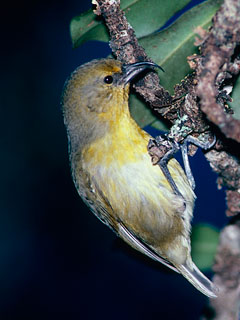
The ʻakiapōlāʻau, pronounced ah-kee-ah-POH-LAH-OW, is a species of Hawaiian honeycreeper that is endemic to the island of Hawaii. Its natural habitats are dry and montane moist forests, and the only bird species on the island to occupy the woodpecker niche. The bird is 5.5 inches (14 cm) in length, and has an unusually curved beak-(a specialist species). The ʻakiapolaʻau is a pudgy bird which has a whitish bottom and tail, black legs, yellow chest, orangish head, black face mask and bill and gray black wings. The male's song is either a loud, short pit-er-ieu or a rapid warba-warba. Its various calls include an upslurred whistle, a short cheedle-ee warble, and a short sweet. Due to the recent disappearance of the Kauai nukupuʻu in the 1900s and the Maui nukupuʻu in the 1990s, leading to fears that they may be extinct, the ʻakiapōlāʻau may be the last of its genus. It is the only member of the subgenus Heterorhynchus, which has a woodpecker-like feeding habitat and exclusively preys on insects, in contrast to the nukupu'us, which were both insect-eaters and also hummingbird-like nectarivores.

The ʻapapane is a small, crimson species of Hawaiian honeycreeper endemic to the Hawaiian Islands. They are the most abundant and widely distributed honeycreeper and are found on the islands of Hawaiʻi, Maui, Lānaʻi, Kauaʻi, Molokaʻi and Oʻahu.

The Hawaiʻi creeper, Hawaii creeper or ʻalawī is a species of Hawaiian honeycreeper endemic to the Big Island of Hawaiʻi. Its natural habitats are dry forests and montane moist forests at elevations of 1,000–2,300 metres (3,300–7,500 ft). There are a total of 12,000 birds separated into three populations. A fourth population on the western part of the island probably represents migratory birds from one of the existing population. The Hawaiʻi creeper measures 4.5 inches (11 cm) and has drab green plumage. In 2017 the traditional Hawaiian name was rediscovered as 'alawi'.

The ʻākohekohe, or crested honeycreeper, is a species of Hawaiian honeycreeper. It is endemic to the island of Maui in Hawaiʻi. The ʻākohekohe is susceptible to mosquito‐transmitted avian malaria and only breeds in high‐elevation wet forests.

Awaous stamineus is a species of goby native to the Hawaiian Islands. It has been considered a synonym of Awaous guamensis but recent work based upon morphological and genetic differences has recognized Hawaiian populations as being distinct. Consequently, Hawaiian Awaous are now recognized as a valid, distinct species.

The Oʻahu nukupuʻu was a species of nukupuʻu which was similar to its cousins from the Islands of Kauaʻi and Maui.
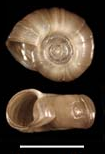
Planorbella duryi, common name the Seminole rams-horn, is a species of air-breathing freshwater snail, a pulmonate gastropod mollusk in the family Planorbidae, the ram's horn snails.

Scotorythra paludicola, the koa looper moth, is a moth of the family Geometridae. It was first described by Arthur Gardiner Butler in 1879. It is endemic to the Hawaiian islands of Kauai, Oahu, Maui and Hawaii.
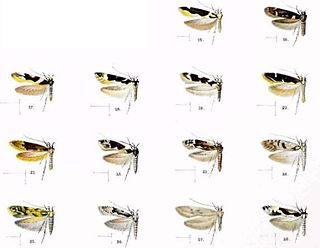
Hyposmocoma blackburnii is a species of moth of the family Cosmopterigidae. It was first described by Arthur Gardiner Butler in 1881. It is endemic to the Hawaiian island of Maui. The type locality is Haleakalā.

Uresiphita polygonalis is a moth of the family Crambidae. The species was described by Michael Denis and Ignaz Schiffermüller in 1775. It is found in the Pacific, including Hawaii and New Zealand, Sri Lanka, Europe and northern and southern Africa.

Cryptophlebia illepida is a species of moth in the family Tortricidae that is endemic to the islands of Kauaʻi, Oʻahu, Molokaʻi, Maui, Lānaʻi and Hawaiʻi. Common names include koa seedworm, klu tortricid, koa seed moth, litchi borer, litchi moth, macadamia nut borer and macadamia nut moth. It was first described by Arthur Gardiner Butler in 1882.

Coleotichus blackburniae is a species of insect in the family Scutelleridae, the jewel bugs. It is commonly known as the Koa bug or the Koa shield bug. It has been dubbed the stinkless stink bug for its lack of the malodorous defensive chemicals present in other heteropterans. It is Hawaii's largest endemic true bug.
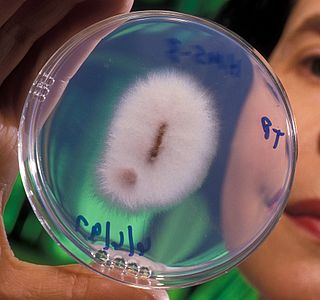
Koa wilt is a relatively new disease to Hawaii, discovered in 1980. Koa wilt is caused by a forma specialis of the fungus Fusarium oxysporum, which is now abundant in Hawaiian soils and infects the native Acacia koa tree, a once-dominant species in the canopy of Hawaiian forests. Fusarium oxysporum f.sp. koae is believed to have been brought into Hawaii on an ornamental acacia plant. Fusarium fungi clog the tree xylem, causing significant wilt and mortality among these beautiful and iconic Hawaiian trees.

Atyoida bisulcata, also called ʻŌpae kalaʻole or ʻŌpae kuahiwi in Hawaiian, is a species of freshwater shrimp endemic to Hawaiʻi in the family Atyidae. It was described in 1840 by John Witt Randall and is the type species for the genus Atyoida.
